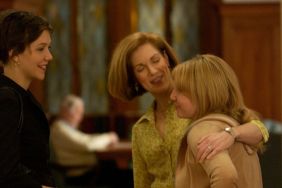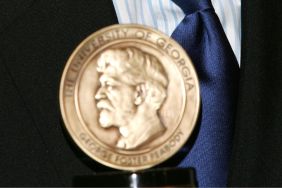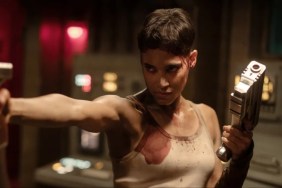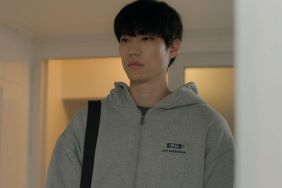Tune in, drop dead

America’s next zombie apocalypse will be televised. But you won’t be seeing much of it. In the indie feature Dead Air much of the action is going to be left to the imagination via frantic phone call made to a popular talk radio program led by Logan, played by genre fave Bill Moseley (The Devil’s Rejects). “The action is 65-percent inside and 35-percent outside,” actor-turned-director Corbin Bernsen (The Dentist, “Masters of Horror: Right to Die”) tells Shock Till You Drop during a lunch break on the set of his third outing behind the camera.
“Talk radio is something you cannot see so it’s all in sound and hearing. Part of the horror here, to me, is the…what if I told you right now, ‘I hate to tell you this but I have a contagious airborne toxin in my system.’ And you can’t see it, you can’t smell it. I’m telling you that in 72 hours you’re going to be dead. That’s how it works, so the metaphor of talk radio is you can’t see this shit happening you can only hear it. The virus is outside infecting dead air and it’s also about the radio dead air. Here, [much of the story takes place] inside, but the infection outside comes into the body of the building and works its way up to the head – which is where the station is.”
It’s the radio station set that Shock is visiting on an unseasonably brisk Saturday afternoon before Easter. Producers Jesse Lawler and Chris Aronoff of Antibody Films have been overseeing the production in a small soundstage in North Hollywood; inside or outside, there are no walking dead to be seen today. In fact, as we pull into the surrounding suburban neighborhood, it’s eerily vacant for a weekend. Porches empty. Lawns free of rugrats running around. An apropos tone-setter – as if something had driven the people out of their homes.
But if this was truly the world of Dead Air, the streets would be overrun with chaos. Scripted by Ken Yakkel (co-producer of the hit animated web series Xombie), the 28 Days Later-inspired story poses a haunting, and much hypothesized, “what if?” when a terrorist detonates a bomb at a packed baseball stadium. What is released is a contagion that infects the city’s population sending folks into fits of uncontrollable violence. Meanwhile, looming in a tower high above the disaster, the crew of a talk radio station tries to make heads-or-tails of what is occurring down below. “It’s like a PCP zombie movie, that’s my take on it ’cause they’re not really dead,” clarifies Yakkel. Okay, but until ol’ Kenny comes up with a better term for his spaz-attackers, we’ll keep calling them zombies for the purpose of this visit.
Joining Moseley as the shock jock (more Tom Leycus, less Howard Stern and not a hint of Imus) ruling the airwaves is Patricia Tallman (“Babylon 5”), reuniting the two for the first time since their days as the ill-fated Johnny and the prone-to-fits-of-screaming version of Barbara, respectively, in Tom Savini’s Night of the Living Dead remake. Tallman plays Lucy, “[Logan’s] ex-wife,” she explains. “She supports his type of radio and appreciates his edgy and ballsy attitude. It’s obvious they couldn’t live together but they still work together. I support him and he needs what I bring to the table. They’re a good working team.” Moseley interjects, “Kind of like Fleetwood Mac!” Rounding out the cast are Anthony Ray Parker (The Matrix), David Moscow (Big) and TV vet Navid Negahban as the terrorist, responsible for the film’s cataclysmic events, who later disrupts Logan’s broadcast.

“It was a culmination of 9/11 and George Romero’s Dawn of the Dead,” Yakkel explains of his conservatively located plot. “It’s a paranoia movie that mostly takes place on one set. A reverse War of the Worlds. Instead of Orson Welles telling the world it’s everyone on their cell phones calling into the radio station and they’re [in turn] re-broadcasting this stuff to people in their cars or homes who are not in the center of things just yet. Since we’re on a limited budget, I thought I’d write something smaller and specifically write something with the majority taking place in one or two locations with some exterior stuff elsewhere.”
“George Romero’s movies, with all due respect, are great,” adds Bernsen. “Those are the films that made you go home, lock your doors and close your curtains. We live in a society today, though, where everybody knows everything. People are smarter, we’re inundated by images of Iraq, so what’s scary now is to put into your head something like the idea that the next time you go to a baseball game and you see somebody who looks suspicious…maybe where you’re at isn’t a good place to be. That’s the next step, put the genre into a realistic environment. I think today’s audience, in order to sustain their fear you got to base it in something they might have read about in today’s papers.”
A trip around the soundstage takes us past a munching cast and crew to an area cordoned off for what appears to be a Presidential podium – perhaps for a telecast State of Emergency announcement. Through a padded door we step into a vastly larger area – the station set. To the right, a fully furnished lobby with a row of framed black & white stills of the station’s radio celebs adorning the wall. Moseley’s Logan is up there; Bernsen sneaks in a cameo here as well. Eating up most of the square feet is the detailed and convincing DJ booth, designed and built by Bernsen and his brother.
“I built the sets so I knew what I was getting into,” Bernsen says addressing whether the possible restrictions of such a tight setting can visually bind a director. “I will say, when you have 60-pages to keep coming up with something different it’s been a challenge, but I take budget limitations and try to turn them into opportunity. I embraced early on that we’re here and you can only cover something so many ways without looking crazy. It’s okay if we come back to the sameness a little bit. As long as the interactions are interesting and the outside events are crazy. We got a lot of cool stuff though. If you look at the mic stands, they’re jutting up like these alien arms and you’ve got the reflections in the glass of the booth,” he holds his breathe, mentally tallying the coverage he has gotten and will need. “Yeah, there’s enough ways to sustain this visually.”
As for those aforementioned carpentry skills, Bernsen and his brother put them to use on the former’s prior directorial effort Donna on Demand. When that film was completed, Bernsen was looking to test his chops at horror – he felt ‘Dead’ was a breath of fresh air. “You’ve got this DJ booth which is like a vacuum, outside it’s totally crazy but inside here it’s quiet, you can hear a pin drop until they speak on the radio,” he says. “The idea is this fortress becomes penetrated and that’s what’s scary to me. Not to mention these people locked in the top of the building not knowing what shit is happening.”
Production will wrap for a spell later in the week while Bernsen resumes his work on the television series “Psych” for the USA Network. It’s an unconventional method to tackling a feature production but Bernsen says the break will do him some good because when he returns shooting will begin on all of the outdoor coverage where much of the zombie action takes place.

And when it comes to those pesky flesh eaters, critics and fans alike have exhaustively mulled over undead cinema as a cultural reflection. With a plot that anchors itself in a form of the mass media, the doors are open to further subtextual analysis. When asked why he opted to set his film – a character study as well as a promising new chapter in the zombie pantheon – in the world of radio, as opposed to television (think the opening moments of Romero’s Dawn of the Dead, Yakkel explains, “At one point there is somebody in our film who is attacked in a television studio. [Logan and company] are watching it up on the screen and there’s nothing you can do but watch it live. Radio seemed cooler for some reason, I think with broadcast television you’re not getting into people’s cars. At one point we have a guy who’s on his cell phone saying, ‘I’m stuck in gridlock and there’s people getting yanked out of cars.’ And he’s ducking down, sitting on the floor of his truck then you can hear [the zombies] breaking into his windows. You don’t technically see it but you hear it.”
Moseley agrees with the screenwriter’s cogent take. “What’s interesting about that is you realize how limited television is – here’s an image and there’s commentary. But you’re getting such a narrow band of information whereas, in this situation, so much is unknown and crazy, the fact that we’re not getting the bigger picture and we’re getting calls from people on the street who have these personal opinions about what we’re seeing and what’s happening. It reminds me of the original Night of the Living Dead. When Barbara gets to the farmhouse she is in shock, so there’s no information, the first source is a radio. After the radio they then discover a TV, so it’s expanding from no information to the radio and so on.”
“It makes it even more claustrophobic,” contributes Tallman. “You can’t see out, we can’t see out. I know that’s true with a TV station but we’re in an insulated room at the top of a skyscraper. There’s something about that and the people calling in and we’re hearing their voices and screaming and gunshots. Not knowing what the information is – it’s coming in unclear and everyone’s got a different opinion. It’s incredibly nerve-racking, you feel blind and shut-off. It feels like being back in the farmhouse.”
Dead Air is expected to be completed this Fall for a 2008 release.



Source: Ryan Rotten









